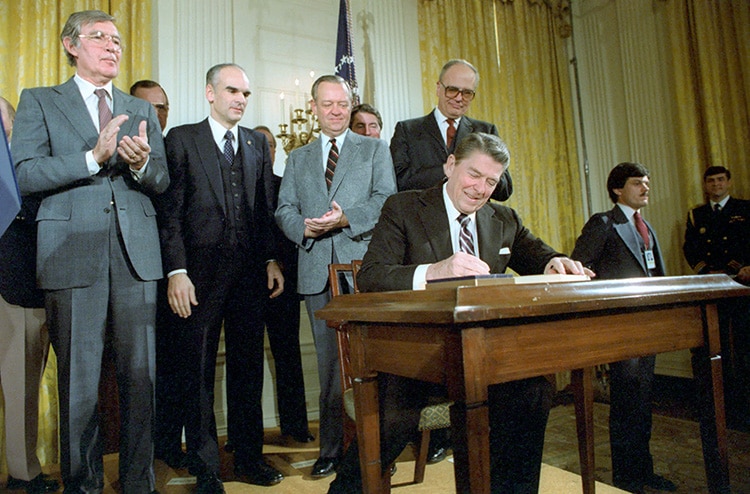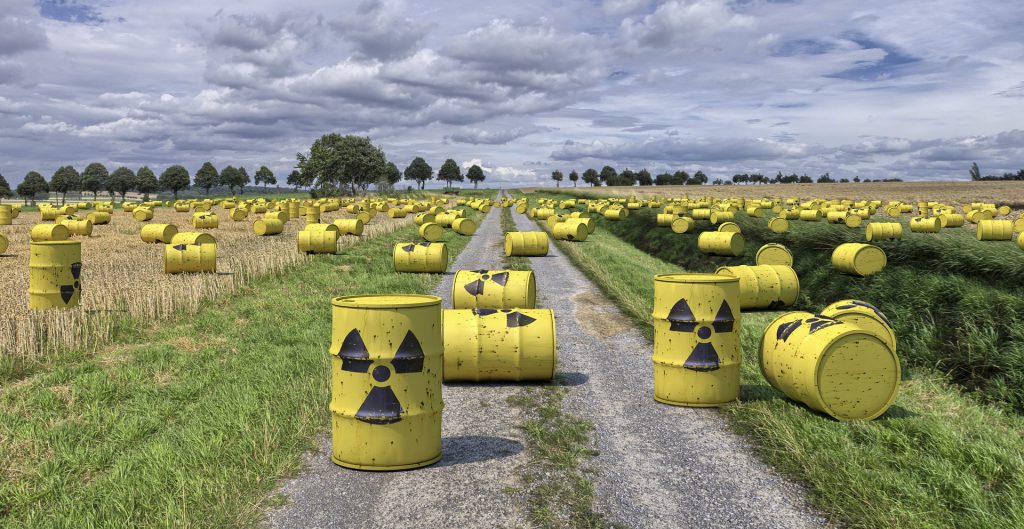“The nuclear industry’s position in support of spent fuel legislation is tempered by a combination of reality and priorities. While the industry regularly testifies in favor of finding a long-term solution to the spent fuel problem, the reality is that state legislative prohibitions on the construction of new nuclear reactors are meaningless, given that no new reactors are planned in the foreseeable future. It is uneconomic and/or not politically viable to build a new reactor in the United States—even one of the small modular reactors under development.”
BY: JDAVID KLAUS | thebulletin.org
The 92-page platform adopted at the Democratic National Convention does not include a single sentence on the issue of how to manage the more than 80,000 tons of spent nuclear fuel sitting at 70 sites in communities across the country. The Republicans adjourned without adopting any new platform for 2020, leaving their 2016 platform in place—but it also did not address the nuclear waste issue.
Ironically, political interest in addressing the spent fuel issue is decreasing at a time when the number of closed nuclear plants in the United States is increasing—and it is common practice to level the plant and leave the spent fuel behind. If the issue had been as significant a political priority today as it was in the past, it would have been included in one or both of the platforms.
In its 2004 and 2008 platforms, the Democratic Party committed to “protect Nevada and its communities from the high-level nuclear waste dump at Yucca Mountain, which has not been proven to be safe by sound science.” Republicans, in their 2012 platform, focused on how “[t]he federal government’s failure to address the storage and disposal of spent nuclear fuel has left huge bills for States and taxpayers.”
There was a glimmer of hope when President Trump came to office in 2016, and the Republicans controlled both the House and Senate, that progress would be made on the issue of nuclear waste. At that time, then-Senate Majority Leader Harry Reid of Nevada no longer had the equivalent of a veto over any legislation on the issue. But with the 2020 elections around the corner and Congress winding down, it is clear that is nothing is going to happen anytime soon. Why? Because none of the organizations claiming they want a permanent waste disposal facility is actually serious about a solution.
The missing coalition. There should be a powerful coalition of diverse interests working to find a permanent disposal path for the thousands of tons of spent nuclear fuel held in temporary storage facilities at commercial nuclear plants across the country. That coalition would include:
- Utilities with nuclear reactors—many of them permanently closed or closing—that are being forced to build, operate, and secure storage facilities for over 80,000 tons of spent nuclear fuel accumulated over decades of operation;
- The US government, which has the legal obligation to take back the spent fuel and, per court orders, currently pays in excess of $600 million per year to utilities to store that material;
- The nuclear industry, which is directly prohibited by state law from building new nuclear plants in eight states until there is an established disposal path for spent nuclear fuel, and is effectively restricted by the waste issue in many other states; and
- Environmental groups, which are concerned about the safety and security of storing tons of nuclear materials at sites in or near communities across the country.
Such a coalition of diverse interests should be an effective political force. Why hasn’t it produced any results?
The answer is that, notwithstanding their public statements, none of these potential interests really supports addressing the spent fuel issue or is willing to make it a political priority.
Economic disincentives. For the nuclear utility companies, nuclear waste management is a matter of simple economics. Under current court orders, the US government covers the utilities’ cost for storing spent nuclear fuel. In addition, the courts have put a freeze on utility payments to the Nuclear Waste Fund. Every legislative proposal to address the spent fuel issue reinstates utility payments to the fund and potentially shifts short-term storage costs back to the utilities.
For Congress and the White House, enthusiasm for ending the current $600 million per year payments to the utilities is complicated by budget scoring rules. Today, payments to utilities are made out of the federal government’s Judgment Fund, because they are required by court order rather than statute. The Judgment Fund is an indefinite appropriation and is considered to be off-budget, which means payments from the fund are not counted in the budget scoring system or allocated against specific accounts. Legislation to address the spent fuel issue would change that, forcing appropriators to find $600 million in savings from other programs or to identify new revenue sources to offset the expenditure. It’s easier for Congress and the administration to keep their heads in the sand.
The nuclear industry’s position in support of spent fuel legislation is tempered by a combination of reality and priorities. While the industry regularly testifies in favor of finding a long-term solution to the spent fuel problem, the reality is that state legislative prohibitions on the construction of new nuclear reactors are meaningless, given that no new reactors are planned in the foreseeable future. It is uneconomic and/or not politically viable to build a new reactor in the United States—even one of the small modular reactors under development. The nuclear industry has other significant political issues related to its existing fleet of reactors, and these have pushed the spent fuel issue toward the bottom of the priority list.
Within the environmental community, the position on spent fuel legislation is mixed. Those environmental groups opposed to nuclear power welcome the lack of action on the spent fuel issue because, among other reasons, it preserves the statutory prohibition in those states where a disposal pathway is a condition of building new nuclear plants. For the relatively few environmental groups that see nuclear power as a potential means to address climate change, it becomes a question of priorities very similar to that of the nuclear industry. There is little reason to expend political capital to address an issue that would not change the real outlook for expanding nuclear power in the United States, particularly if the position runs contrary to the dominant view within the environmental community.
Reaching a consensus. What, then, is the future of nuclear waste, and what forces are going to drive this issue to resolution? It is probably unrealistic in the near term to expect the government to site and begin development of a permanent underground repository. However, the obstacles to building one or more consolidated interim storage facilities are not that significant. In fact, two private entities are working to permit and build consolidated interim storage facilities—their applications are pending at the Nuclear Regulatory Commission. Congress needs to do little more than remove the statutory requirement that a permit for a permanent repository be issued prior to moving forward on interim storage. Alternatively, Congress could authorize the government to cover the cost of storing spent fuel in a consolidated interim storage facility.
Ultimately, leadership on the issue is going to have to come from a president and congressional leaders who take seriously the US government’s legal obligation to accept commercial spent fuel and build a long-term repository to hold it. This obligation is grounded in nonproliferation policy and was established by statute in the Nuclear Waste Policy Act of 1982.

Oddly, a consensus that the law needs to be changed emerged in the lead-up to the Nevada presidential primary election, when all candidates—including President Trump—announced their opposition to continued development of a long-term repository at Yucca Mountain. Whether that consensus on the need for change evolves into an actual solution will depend on the president who takes office this coming January, and the willingness of the parties that have an institutional interest in finding a solution to look past the reasons they have not done so in the past.

